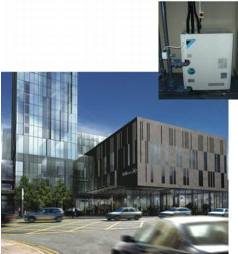Air conditioning in a world of climate change

Helping the Hilton Hotel that is part of the 171 m-high Beetham tower in Manchester meet the carbon-emission requirements of Part L of the Building Regulations is a Daikin water-cooled VRV installation. Air conditioning for 285 bedrooms, reception, restaurants, meeting rooms etc. is provided by 25 water-cooled VRV condensing units serving 328 fan-coil units.
The energy used by air conditioning is often seen as contributing to the carbon-dioxide emissions that cause global warming. However, comfort cooling and reduced emissions can go together, as John Durbin explains.According to the Carbon Trust, buildings account for about 40% of the total carbon emissions in the UK. As a result of rising energy costs, coupled with Government legislation to reduce carbon emissions, a greater demand has been placed on businesses to be more energy efficient. With increasing pressure mounting on industry to improve equipment efficiencies and reduce carbon emissions, systems such as Daikin’s VRV technology for air conditioning [called VRF by other suppliers] was launched into the European market place to address some of the global concerns.
Increasing the scope of VRF Until the year 2000, all VRV/VRF systems had been air cooled. However with the introduction of water-cooled systems, the potential for applications was extended. Water-cooled systems are ideally suited to really tall buildings as there are no restrictions on the lengths of water pipework — unlike refrigerant pipework. There is also the potential of utilising existing water pipework when replacing a chilled-water system. The main difference between a water-cooled VRV/VRF system is that the external air-cooled units are replaced by indoor units incorporating plate heat exchangers. These indoor units are quite small and can be located anywhere in the building. Such water-cooled systems are not intended to replace air-cooled systems but to be used where air-cooled systems are not suitable, with water from an external cooling tower, dry cooler or boiler piped to the heat exchanger. On the other side of this heat exchanger, refrigerant is piped to each indoor unit. The system is designed to offer the best freedom in the design and installation process. Depending on whether the building requires heating or cooling, the indoor unit is supplied with water at temperatures between 10 and 45°C from a cooling tower/dry cooler and, where necessary, a boiler. Daikin’s water-cooled VRV system is available in two systems: 2-pipe, heat pump and 3-pipe heat-recovery system. In the heat-pump system, all indoor units work off the same refrigerant circuit, so they all operate in heating or cooling mode. The 3-pipe heat-recovery system can simultaneously deliver heating or cooling to the units it serves. This enables the user to zone sections of the buildings depending on the needs of each conditioned zone. In commercial buildings, the demand for heating and cooling can vary throughout the day, depending on the number and occupation of workers within a space. Heating and cooling demand also affected by solar gain, and large areas of glazing can cause large fluctuations in temperature.
Heat recovery Heat-recovery systems can in fact use such heat gains to advantage and transfer it to other parts of the building with a demand for heat. The heat-recovery system is ideal where there are high internal gains such as a processing plant or where there are high solar gains. The advantage of heat-pump technology is an energy efficiency up to five times greater than a traditional heating system, achieved by recovering heat from one part of a building and then using it to heat another area. The technology does however require a small amount of external energy to drive the heat pump to transfer heat from one area to another The effect of global warming is becoming more apparent, and it is crucially important that businesses should take on the message of improving energy efficiencies. There are a number of developments within the market place which can help businesses to reduce carbon emissions. Systems such as heat-pump technology combined with air conditioning to utilise heat gains are an important element in reducing carbon emissions from buildings and should be implemented wherever possible.
John Durbin is with Daikin Airconditioning UK Ltd.
Related links:








